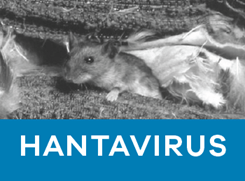Hantavirus infection is a disease caused by rodents infected with the Hantavirus. In Colorado, the rodents that carry Hantavirus are deer mice. The deer mouse is tan/reddish in color, with a white belly - and the tail has a clearly defined white side. Download a Hantavirus information sheet.
Hantavirus in people is very rare, but it can be fatal by causing respiratory failure.
Who gets Hantavirus?
Those at highest risk of getting hantavirus include people who spend time in and around areas where rodents live. This includes people who:
- Open previously unused buildings, like a cabin or shed.
- Work in construction, utility and pest control.
- Camp and hike in areas where rodents are.
- Stir up dust in an area where mice have been.
Cleaning in and around the home, such as during spring cleaning, can also put people at risk for being exposed to hantavirus.
What are the symptoms of Hantavirus?
The first symptoms of hantavirus usually appear after 1-2 weeks, but can be as long as 8 week after exposure. Signs of hantavirus include:
- Fever and chills
- Muscle aches - including severe pain in the legs and back
- Headaches and dizziness
- Feeling very tired or fatigued
- Difficulty breathing
- Stomach issues, including nausea, vomiting, diarrhea and stomach pain
Hantavirus may develop into hantavirus pulmonary syndrome (HPS). HPS can cause the lungs to fill with fluid and lead to respiratory failure.
How is Hantavirus spread?
People can get Hantavirus by:
- Breathing in the virus during exposure to rodent urine and droppings that are stirred up into the air.
- Touching eyes, nose or mouth after touching rodent droppings, urine or nesting materials containing the virus.
- In rare cases, a bite from an infected rodent.
The virus does not spread between people or pets.
How to prevent Hantavirus
- Keep mice and rats out of your home and building.
- Seal wall gaps and window screens to keep rodents out of your home.
- Remove wood, junk and brush piles near your home. Keep vegetation around the house well-trimmed.
- Set out snap traps to catch rodents, and monitor them daily.
Cleaning up after rodents
- If cleaning a dusty area where mice have been, use a respiratory mask and wear rubber, latex or vinyl gloves.
- Open the door and air out the space for at least 30 minutes before entering.
- Clean up droppings with a mixture of bleach and water (mix 1.5 cups of bleach with 1 gallon of water).
- Wet areas where rodents have been with the bleach solution.
- Let soak for 5-10 minutes before cleaning up with a mop, sponge or wet vacuum.
- After disinfecting, place mouse carcasses, nests and cleaning materials into a plastic bag. Tie the bag shut and put in an outdoor trashcan.
- Items that cannot be disinfected (e.g., paper, wood, fabric) should be carefully set outside in the sun for 2-3 days. Sunlight will help kill the virus.
- Wash hands with soap and water after cleaning areas affected by rodents.
- Keep foods (including for animals/pets) in tightly sealed and un-chewable containers.
How is Hantavirus treated?
Currently, there is no treatment for Hantavirus, so people who think they have it should contact their physician immediately to get supportive care with medication.
For more information or assistance, call Denver Public Health 303-602-3614, or Denver's Department of Public Health and Environment at 3-1-1.
Sources:



